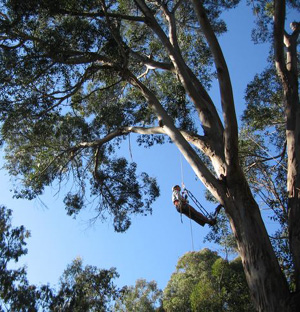A new survey has determined that the UC Santa Cruz Arboretum's collection of eucalyptus trees and shrubs is the most diverse anywhere outside of Australia. The finding is the result of an inventory conducted this summer by Matt Ritter, a visiting scholar at the Arboretum. Ritter is assistant professor of biological sciences at California Polytechnic State University, San Luis Obispo, and director of the Cal Poly Plant Conservatory.
Initial investigations led Ritter to declare the UCSC eucalyptus collection the largest in California, but he upgraded his assessment as he continued his work cataloging the collection. The project led him 100 feet into the air to sample leaves and flowers from towering eucalyptus trees. At first he worked from a cherry-picker truck, but when the lift topped out short of the lowest branches on some trees, Ritter and Cal Poly graduate student Jenn Yost turned to ropes and harnesses.
For most Californians, the word eucalyptus brings to mind the hulking blue gum trees that line many coastal highways. But more than 300 other species have been introduced to the state, Ritter said. About 100 of those grow in the UCSC Arboretum, and some species don't grow anywhere else in the state, he added.
Highlights of the Arboretum collection, Ritter said, include the oldest spinning gum in the state and two karri trees that, at nearly 200 feet high, are likely the tallest in the state. A whipstick mallee ash is probably the only tree of its kind in California, he said. This information is from a forthcoming article by Ritter in the Bulletin of the UCSC Arboretum Associates.
When it comes to eucalyptus, the UCSC Arboretum's closest competitors are botanical gardens in the Los Angeles area and at UC Davis, Ritter said. California's climate, which closely matches that of the trees' home range in Australia, is the key to their success here. In many other parts of the world, the trees just can't handle the weather.
Some eucalyptus species--notably the blue gums--have become pests that crowd out native California vegetation, said Stephen McCabe, director of education at the Arboretum. During his time at the Arboretum, Ritter examined which eucalyptus species are capable of reproducing in California, as a way to investigate which of them might become pests. Ritter identified 10 species whose seeds had begun to grow in the grove and which might be better left out of other California nurseries, McCabe said.
Over the next few months, Ritter plans to install larger labels throughout the collection and to plant appropriate understory plants. When he's finished, he hopes the eucalyptus grove will provide visitors an authentic Australian forest experience.
The Arboretum's eucalyptus collection was started by UCSC's first chancellor, Dean McHenry. Chosen from 80 species donated by Max Watson, the first plantings were made in summer 1965 by forestry students from Cabrillo College as UCSC prepared for its first year of operation. By 1970, the eucalyptus collection tallied 160 trees of 56 varieties.
The Arboretum is already known for having the largest assemblage of Australian plants outside of Australia. The Arboretum's collections of other, slightly more obscure plant groups may also be unrivaled outside of Australia, including the Arboretum's more than 150 Grevillea and 40 Banksia species.
Ritter's work builds on that of a previous researcher, Grace Heinz, who was sponsored in her work by Donald and Diane Cooley. Additional species have been collected since Heinz's work at the grove in the 1970s.
The Arboretum is located off High Street in Santa Cruz. It is open 9 a.m. to 5 p.m. daily and can be reached at (831) 427-2998. The gift shop is open from 10 a.m. to 4 p.m. daily. For additional information, see the Arboretum web site.



